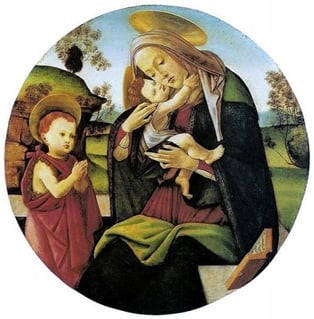Our children are growing up in a world that no longer appreciates true beauty. When they are finally exposed to true beauty through the various mediums of fine art, they are unable to process and critique it. And instead of appreciating it, it all seems to them to be - quite frankly - boring.
Many studies have shown the intellectual benefits of stimulating a child’s brain through the fine arts, whereas constant exposure to the simplistic and base entertainments inhibits their growth. This in itself is something parents should be concerned about. But now consider what a constant diet of ‘junk art’ must do to their souls.
Whether you believe that life imitates art, or art imitates life, what our children see today is far from the kind of life Our Lord wants them to imitate. We are constantly bombarded with the ugly, the depraved, and the base. TV shows, music and advertising all appeal to our most base appetites and conjure up emotional responses. Instead of stimulating the intellect, we look to stimulate our emotions and the more addicting this sort of entertainment becomes, the more it inhibits our ability to absorb what is truly beautiful around us.
Go through most religious stores these days and there seems to be a large amount of shelf space dedicated to cartoon-like statues of angels and cutesy-looking representations of Our Lord. Religious books, both for school and for bedtime, have the same “love, luck and lollipops” view of our faith. It gives one the impression that religion is something to turn to for sentimental reasons, or when one needs a quick “God loves me and everyone goes to Heaven” fix.
Compare Antonio Allegri Correggio’s “The Holy Night’ to a Precious Moments nativity scene. One shows the powerful collision of God coming down to earth and the energy and passion that the nativity enflames in both the angels and the souls on earth, while at the same time gives one an overwhelming sense of hope and peace as one gazes at Mary and the Christ Child. One can prayerfully meditate on this painting for a very long time and gain a deeper understanding of the miracle, the gift and the hope that is Christmas.
The other Christmas Nativity portrayal falls flat on its face in comparison, and all one can say about the Precious Moments nativity is, “Umm…cute.”
What effect must these superficial presentations have on our children? If all they see is the mass-marketed, feel good part, the beauty of our whole faith gets lost. And when they get older and are faced with some of the harder teachings or are suffering great trials, they run back to the cartoon version of faith they had as a child and cannot grow. But by showing them truth presented in all its beauty through fine sacred art, you will stimulate their intellect and train them to search out and examine that which society and pop culture has tried so successfully to keep hidden.
“Yes,” you may say, “but how do I present fine art to my children when I myself do not know enough about it?” If the thought of introducing your family to the fine arts seems daunting, fear not. Simply expose them to the beauties of their faith through art and you will find that talking about both the painting and the faith will be quite easy.
What is it about your faith that you love? Find pictures that reflect what you love about the faith and go from there. Instead of reading to your children at bedtime every night, set aside one night a week to read sacred pictures instead.
Depending on the age of your children, you can discuss many things. Older children can be taught to notice how color, lighting and movement can depict energy and emotions. Younger children will simply enjoy looking at the picture or trying to tell the story the picture portrays.
Pictures of recognizable Bible stories are a good theme to begin with the younger children. Have them choose a Bible story will help them to get excited about “picture night”. Once the desired theme has been chosen, find an appropriate picture to match the theme and read the picture together. Children may appreciate learning a little about the time period the art was created in, or the artist who created it, but this is not always necessary.
If you want to dive a little deeper into religious art and the beautiful faith it portrays, I highly recommend a subscription to The Magnificat. This monthly publication, aside from containing all of the month’s liturgical readings, prayers, and meditations, also gives readers a chance to delve deeper into their faith through art. The full color works of art they share are accented with thoughtful critiques filtered through the eyes of Church history and faith.
As your family learns to appreciate sacred art in all its complexity, beauty, and truth, they will also nurture a deeper appreciation and passion for the Catholic faith itself. Eyes and hearts open to Catholicism’s deeper mysteries and a whole new world will be revealed in glorious ways – so much so that as your children grow and are presented with the simplified, cartoonish portrayals of Christianity today, your children will begin to see that those are the pictures that are, quite frankly, boring.
Copyright 2013 Cassandra Poppe
About the Author

Guest
We welcome guest contributors who graciously volunteer their writing for our readers. Please support our guest writers by visiting their sites, purchasing their work, and leaving comments to thank them for sharing their gifts here on CatholicMom.com. To inquire about serving as a guest contributor, contact editor@CatholicMom.com.



.png?width=1806&height=731&name=CatholicMom_hcfm_logo1_pos_871c_2728c%20(002).png)
Comments